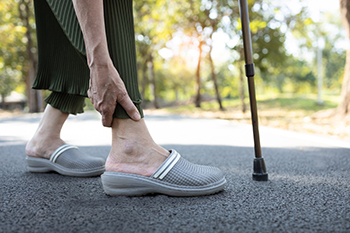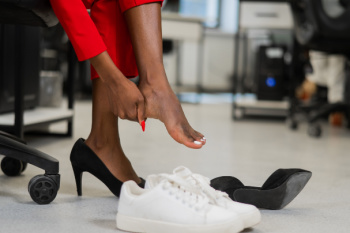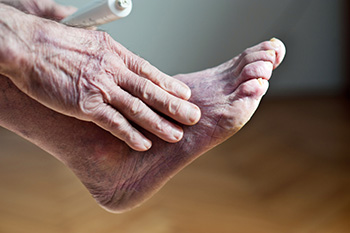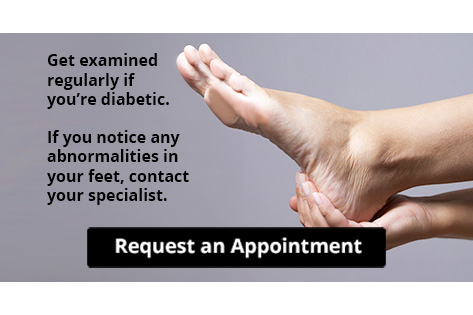Items filtered by date: May 2025
Inspect Your Feet Regularly for Abnormalities if You're Diabetic
Understanding Gait Disorders in Older Adults

As people age, changes in strength, balance, vision, and joint health can lead to gait disorders that increase the risk of falls and limit independence. A gait disorder may involve shortened steps, shuffling, unsteadiness, or asymmetrical walking patterns. These issues can stem from arthritis, neurological conditions, foot deformities, or muscle weakness. Pain in the feet or ankles often contributes to altered walking habits that place strain on other parts of the body. Early identification is important, as many gait disorders can be improved with targeted exercises, proper footwear, assistive devices, or custom orthotics. A podiatrist can evaluate foot mechanics and recommend ways to improve stability and comfort. Regular foot exams are especially important for older adults to detect changes before they lead to serious complications. If walking has become more difficult or unsteady, it is suggested that you schedule an appointment with a podiatrist for a full assessment and treatment options.
If you need your feet checked, contact Gregory Kranzusch, DPM of Foot and Ankle Center of St. Charles County. Our doctors will attend to all of your foot and ankle needs and provide you with quality treatment.
Geriatrics and Podiatry
When people age, some common issues that may occur are bone density loss, dry skin, poor circulation, and rough brittle nails. These issues may also affect your foot health if the necessary steps are not taken to alleviate the problems.
It is important to take care of your feet because feet that are injured or diseased can affect your overall health. Having painful feet hinders your ability to do daily activities or may decrease your willingness to do the things that you need to do.
Visiting Your Geriatrician
As we age, health problems become more likely, so it is essential to visit your doctor for check-ups to ensure that you are doing the best you can to take care of your health. It is recommended to check your feet frequently for any possible cuts, bruises, swelling, corns or any other irregularities.
Taking Care of Elderly Feet
Cracked or dry feet can be treated by applying moisturizer often. It is also important not to wear old socks because the older the sock is, the higher the possibility there will be that there is bacteria there. Wear fresh socks and make sure they fit properly.
Proper foot health means that you can have a more active lifestyle and you will not be bogged down by pain. Foot health also leads to good circulation, which is paramount for overall health.
If you have any questions, please feel free to contact our office located in St. Charles, MO . We offer the newest diagnostic tools and technology to treat your foot and ankle needs.
Ways Running Can Lead to Foot Pain

Running places repeated stress on the foot, often causing pain in the hindfoot, midfoot, or forefoot. Each section plays a vital role in absorbing shock and propelling the body forward. Foot pain from running may arise from overuse, improper footwear, or biomechanical imbalances. Hindfoot discomfort often involves the heel or Achilles tendon, while midfoot pain can result from stress to the arch or ligaments. Forefoot pain is commonly linked to conditions like metatarsalgia or neuromas. Sprains and fractures may also occur from repetitive impact or uneven terrain. Sports injuries are common, especially when training is intense or form is poor. If you like to run and are experiencing foot pain, it is suggested that you contact a podiatrist who can offer appropriate treatment solutions that can get you back to enjoying this sport.
Ankle and foot injuries are common among athletes and in many sports. They can be caused by several problems and may be potentially serious. If you are feeling pain or think you were injured in a sporting event or when exercising, consult with Gregory Kranzusch, DPM from Foot and Ankle Center of St. Charles County. Our doctors will assess your condition and provide you with quality foot and ankle treatment.
Common Injuries
The most common injuries that occur in sporting activities include:
- Achilles Tendonitis
- Achilles Tendon Rupture
- Ankle Sprains
- Broken Foot
- Plantar Fasciitis
- Stress Fractures
- Turf Toe
Symptoms
Symptoms vary depending upon the injury and in some cases, there may be no symptoms at all. However, in most cases, some form of symptom is experienced. Pain, aching, burning, bruising, tenderness, tightness or stiffness, sensation loss, difficulty moving, and swelling are the most common symptoms.
Treatment
Just as symptoms vary depending upon the injury, so do treatment options. A common treatment method is known as the RICE method. This method involves rest, applying ice, compression and elevating the afflicted foot or ankle. If the injury appears to be more serious, surgery might be required, such as arthroscopic or reconstructive surgery. Lastly, rehabilitation or therapy might be needed to gain full functionality in the afflicted area. Any discomfort experienced by an athlete must be evaluated by a licensed, reputable medical professional.
If you have any questions, please feel free to contact our office located in St. Charles, MO . We offer the newest diagnostic and treatment technologies for all your foot care needs.
Understanding Chronic Plantar Fasciitis

Chronic plantar fasciitis is a common cause of heel pain, especially in active individuals. It occurs when the plantar fascia, the thick band of tissue that runs along the bottom of the foot, becomes inflamed due to repetitive stress or strain. Common causes include overuse, wearing improper footwear, high-impact activities, or an abnormal gait. Symptoms typically include sharp or stabbing pain in the heel, particularly with the first steps in the morning or after prolonged rest. The pain may subside during the day but can return after standing or walking for long periods. A podiatrist can diagnose chronic plantar fasciitis through physical exams and imaging tests. Treatment options include custom orthotics to support the arch, targeted exercises to stretch and strengthen the foot, and anti-inflammatory medication. In more severe cases, injections or even surgery may be necessary. If you are dealing with painful plantar fasciitis, it is suggested that you promptly schedule an appointment to see a podiatrist.
Plantar fasciitis is a common foot condition that is often caused by a strain injury. If you are experiencing heel pain or symptoms of plantar fasciitis, contact Gregory Kranzusch, DPM from Foot and Ankle Center of St. Charles County. Our doctors can provide the care you need to keep you pain-free and on your feet.
What Is Plantar Fasciitis?
Plantar fasciitis is one of the most common causes of heel pain. The plantar fascia is a ligament that connects your heel to the front of your foot. When this ligament becomes inflamed, plantar fasciitis is the result. If you have plantar fasciitis you will have a stabbing pain that usually occurs with your first steps in the morning. As the day progresses and you walk around more, this pain will start to disappear, but it will return after long periods of standing or sitting.
What Causes Plantar Fasciitis?
- Excessive running
- Having high arches in your feet
- Other foot issues such as flat feet
- Pregnancy (due to the sudden weight gain)
- Being on your feet very often
There are some risk factors that may make you more likely to develop plantar fasciitis compared to others. The condition most commonly affects adults between the ages of 40 and 60. It also tends to affect people who are obese because the extra pounds result in extra stress being placed on the plantar fascia.
Prevention
- Take good care of your feet – Wear shoes that have good arch support and heel cushioning.
- Maintain a healthy weight
- If you are a runner, alternate running with other sports that won’t cause heel pain
There are a variety of treatment options available for plantar fasciitis along with the pain that accompanies it. Additionally, physical therapy is a very important component in the treatment process. It is important that you meet with your podiatrist to determine which treatment option is best for you.
If you have any questions, please feel free to contact our office located in St. Charles, MO . We offer the newest diagnostic and treatment technologies for all your foot care needs.
Signs of Poor Circulation in the Feet

Poor circulation in the feet may signal an underlying medical condition that limits blood flow to the lower extremities. This issue is often seen in people with diabetes, high blood pressure, or peripheral artery disease. Symptoms of poor circulation may include cold feet, numbness, slow-healing wounds, skin discoloration, or a diminished pulse in the feet or ankles. In severe cases, poor circulation may cause muscle cramps, skin ulcers, or tissue damage due to reduced oxygen delivery. A podiatrist can perform a thorough vascular assessment and may recommend diagnostic imaging to evaluate blood flow in the feet and ankles. Medical treatment may involve prescription medication to reduce clotting, or lower cholesterol and blood pressure. In cases where arteries are blocked, surgery may be considered to restore blood flow. Addressing the root cause early can prevent serious complications like infection or gangrene. A podiatrist can also monitor your foot health over time to reduce the risk of long-term damage. If you have symptoms of poor circulation in the feet, it is suggested that you schedule an appointment with a podiatrist for an exam and appropriate treatment options.
Poor circulation is a serious condition and needs immediate medical attention. If you have any concerns with poor circulation in your feet contact Gregory Kranzusch, DPM of Foot and Ankle Center of St. Charles County. Our doctors will treat your foot and ankle needs.
Poor Circulation in the Feet
Poor blood circulation in the feet and legs is can be caused by peripheral artery disease (PAD), which is the result of a buildup of plaque in the arteries.
Plaque buildup or atherosclerosis results from excess calcium and cholesterol in the bloodstream. This can restrict the amount of blood which can flow through the arteries. Poor blood circulation in the feet and legs are sometimes caused by inflammation in the blood vessels, known as vasculitis.
Causes
Lack of oxygen and oxygen from poor blood circulation restricts muscle growth and development. It can also cause:
- Muscle pain, stiffness, or weakness
- Numbness or cramping in the legs
- Skin discoloration
- Slower nail & hair growth
- Erectile dysfunction
Those who have diabetes or smoke are at greatest risk for poor circulation, as are those who are over 50. If you have poor circulation in the feet and legs it may be caused by PAD and is important to make changes to your lifestyle in order to reduce risk of getting a heart attack or stroke. Exercise and maintaining a healthy lifestyle will dramatically improve conditions.
As always, see a podiatrist as he or she will assist in finding a regimen that suits you. A podiatrist can also prescribe you any needed medication.
If you have any questions please feel free to contact our office located in St. Charles, MO . We offer the newest diagnostic and treatment technologies for all your foot and ankle needs.

